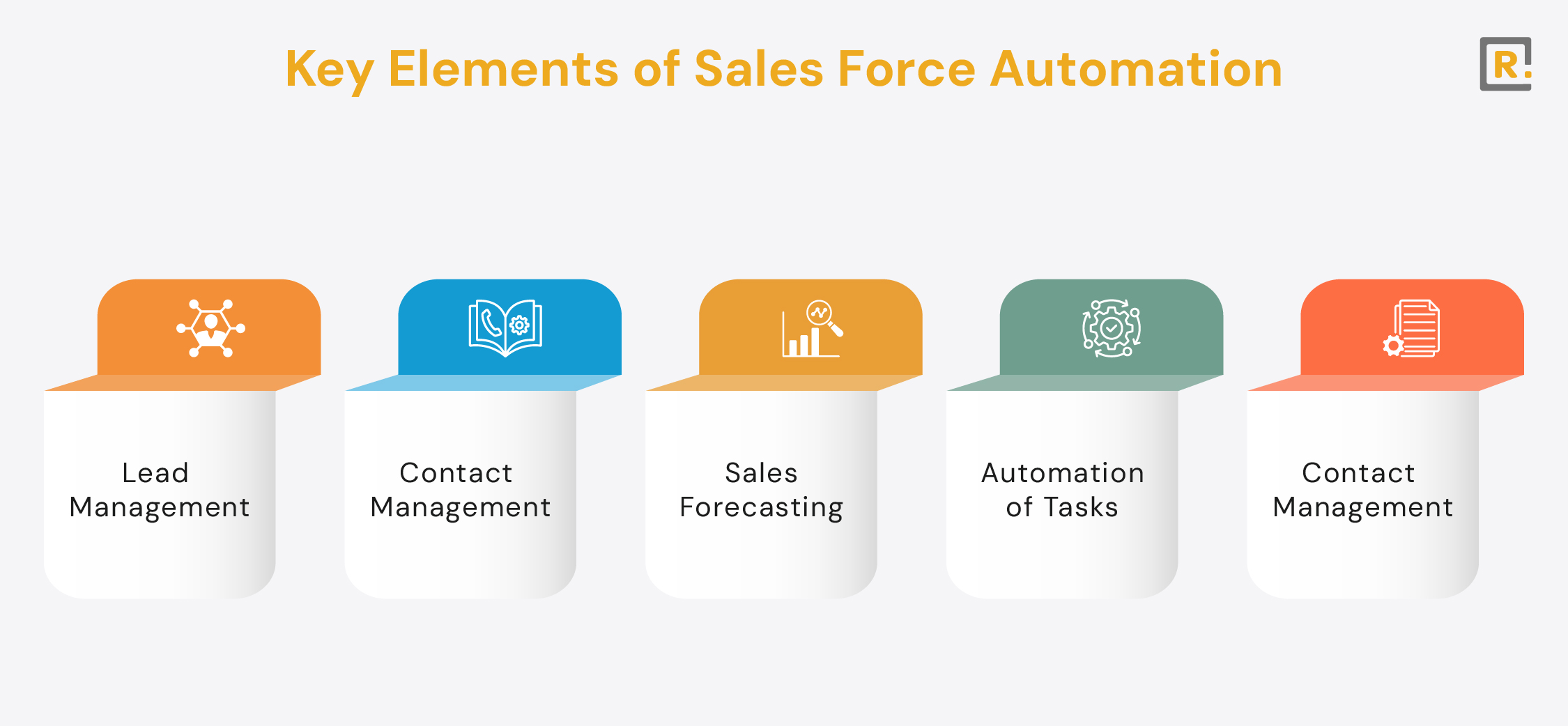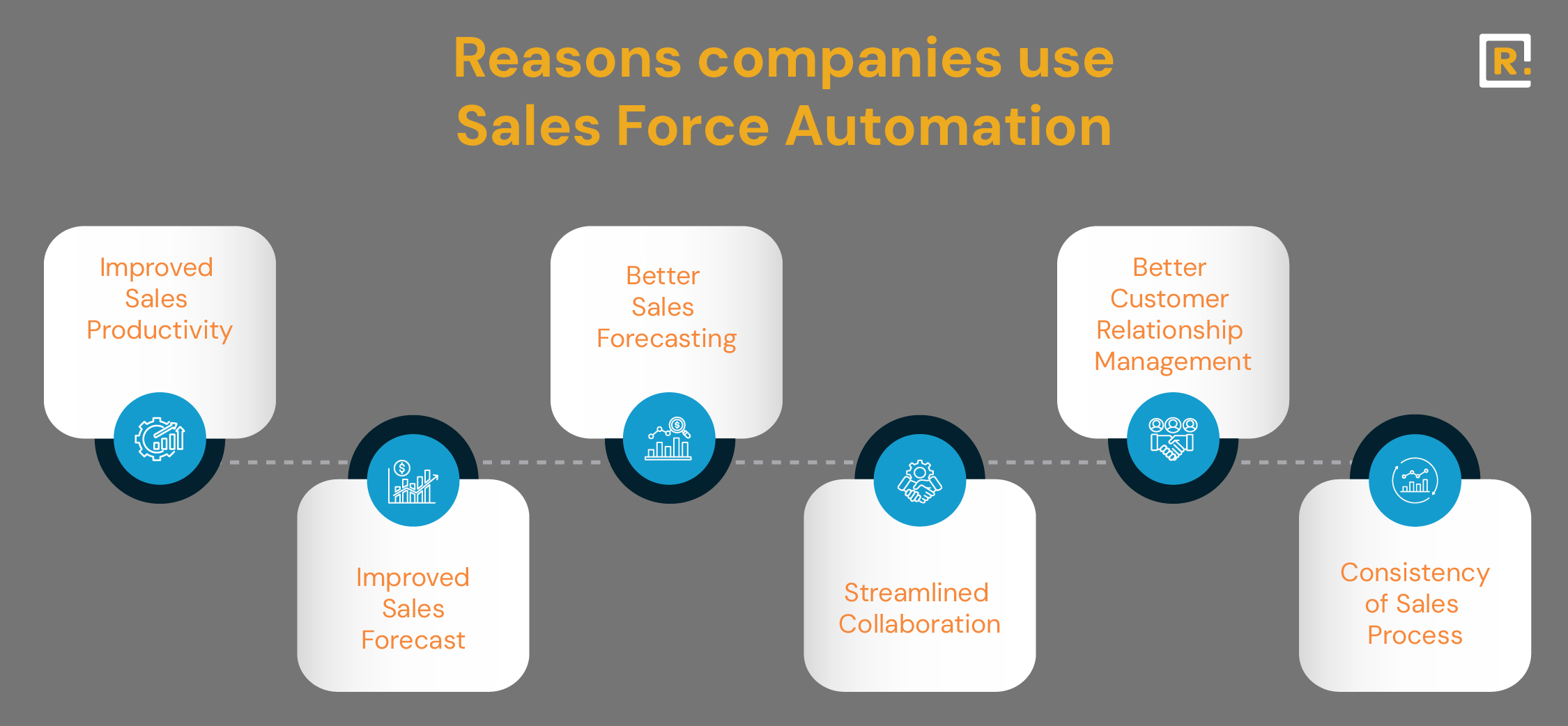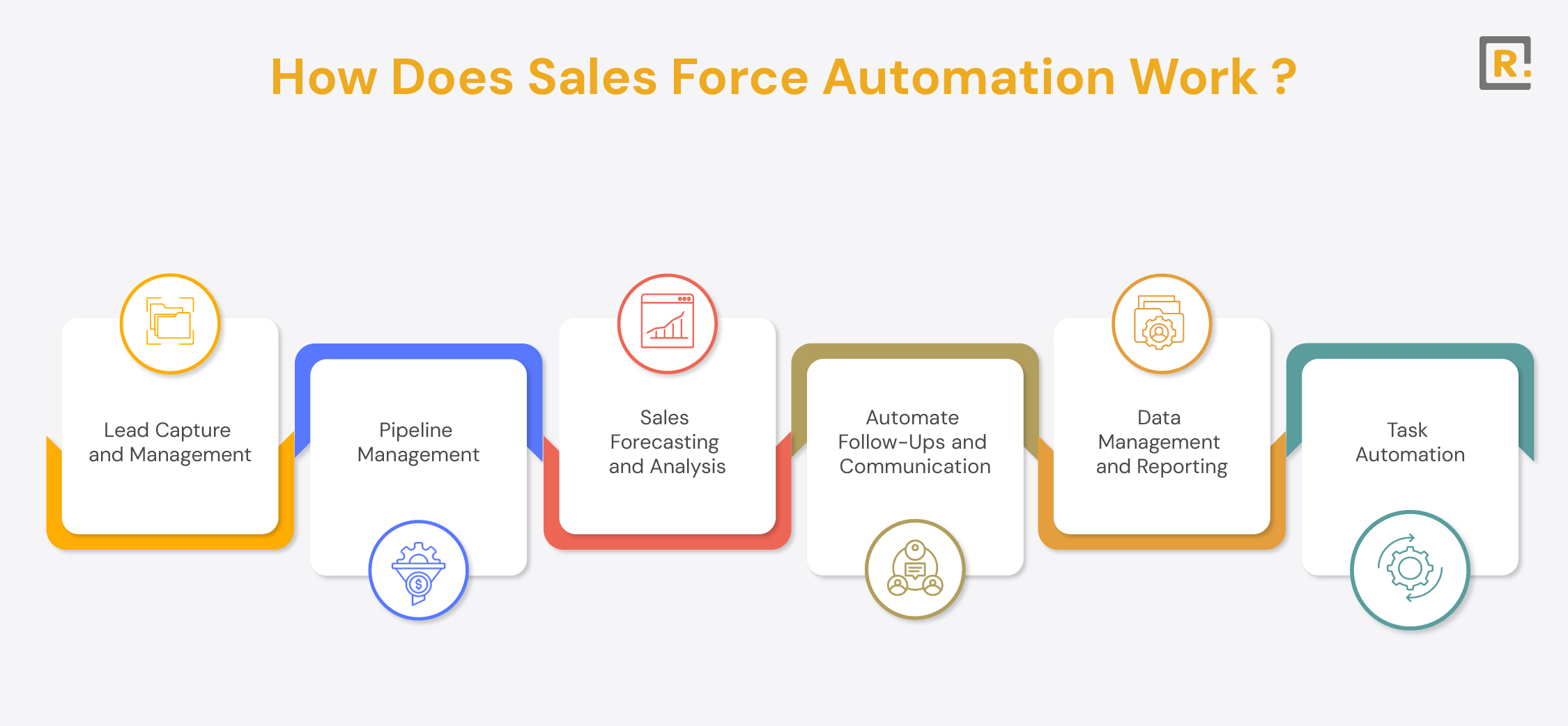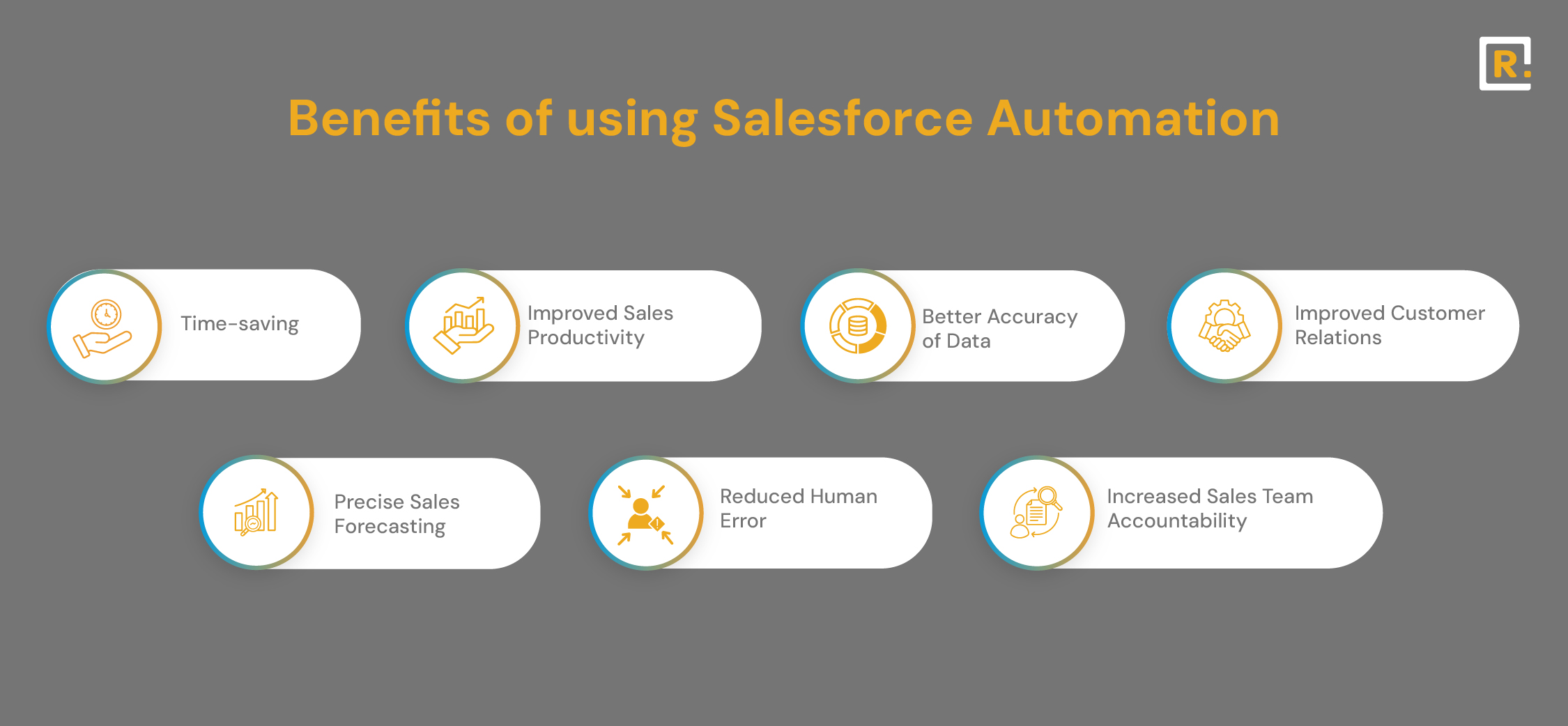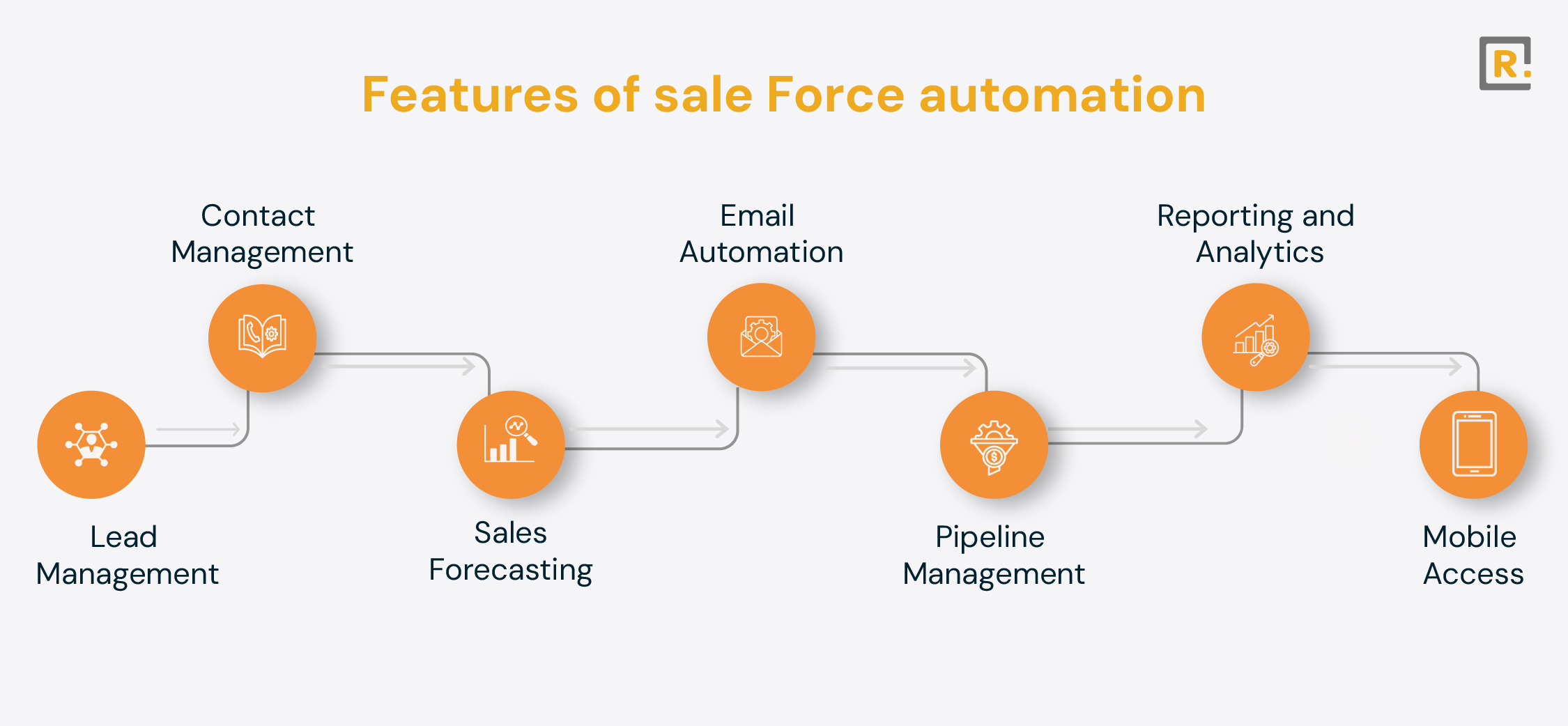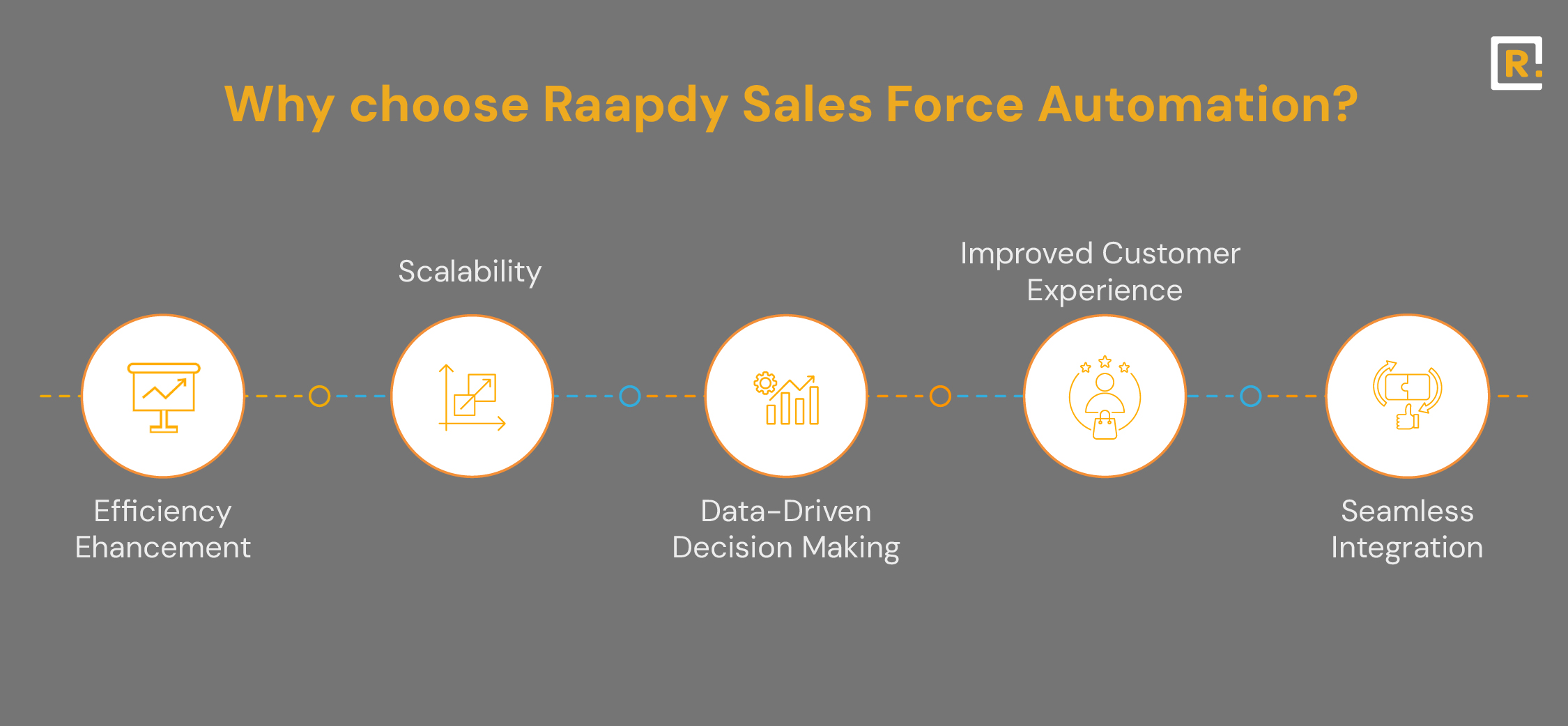-
Solutions
Vendor Management Efficient vendor management platformField Service Management Effective onsite service operationsReal Estate Management Efficient real estate managementAsset Management Efficient asset lifecycle managementDistribution Management System Optimized supply chain distributionDigital Retail Solution Integrated e-commerce solutionsSubscription and Billing System Automated billing and subscriptionsSales Force Automation Optimized sales process automationIntelligent Character Recognition Software Automated text conversion and data extraction
- Why Raapyd
- Insights
- About
What is Sales Force Automation: Benefits and Features
- Sales Force Automation
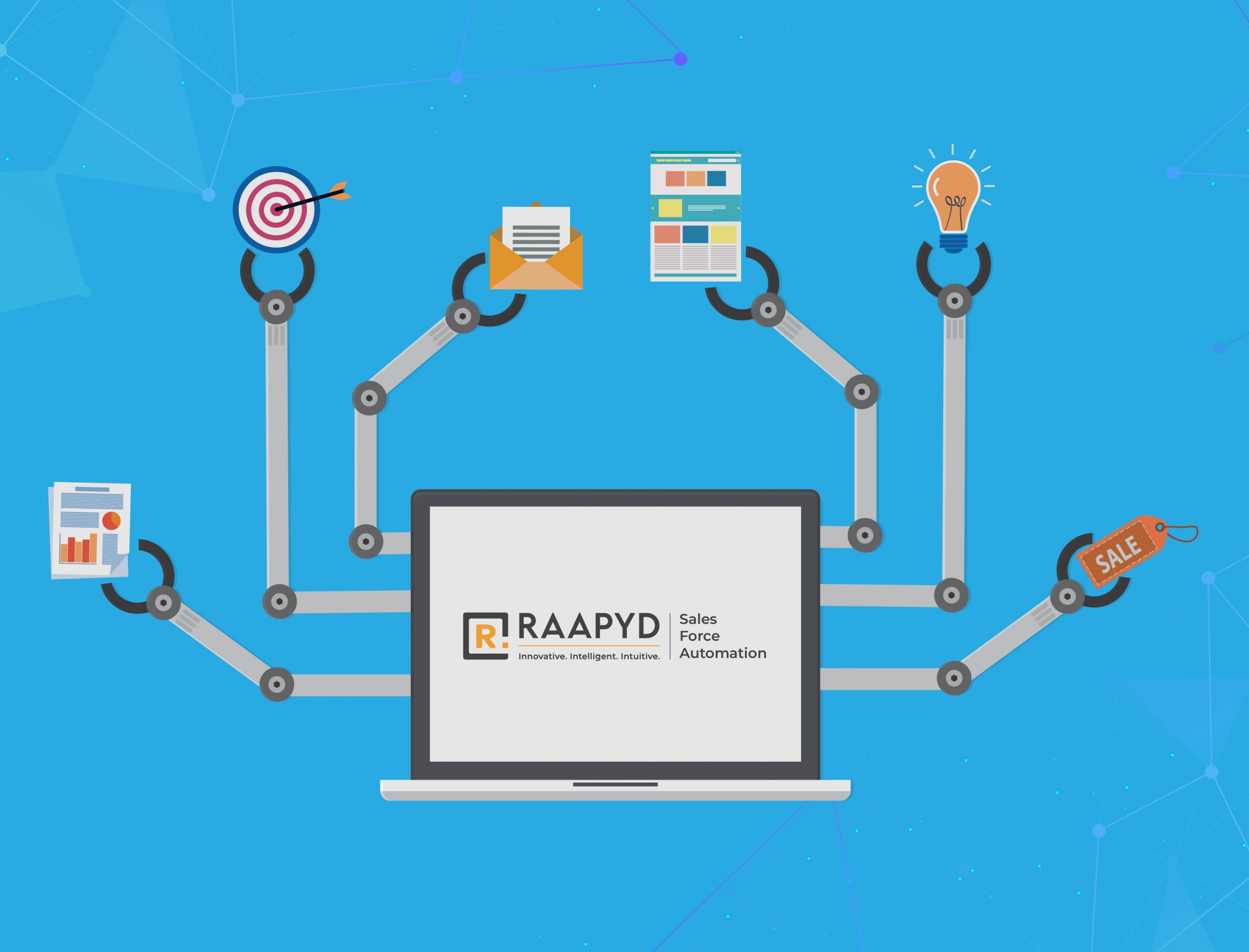
Technology has become indispensable for today’s business to increase efficiency and surpass competitors. Sales Force Automation (SFA), is a software tool which helps companies optimize and improve their sales strategies and achieve increased productivity and increased revenues.
Sales Force Automation caters to automation of various sales-related activities, labor on the manual side of things and gives more time to the teams to look into customer engagement and strategy.
This guide closely examines the different aspects of Sales Force Automation, why it is used in businesses, how it works, and its several features and advantages.
So continue reading as we understand the significant difference between SFA and CRM systems and Raapyd’s role in the process.
What is Sales Force Automation(SFA)?
SFA software is an application to automate essential sales process activities. These may also commonly involve lead management, customer data organization, tracking of sales opportunities, forecasting, and follow-up communications automation.
In other words, SFA takes over certain recurring and time-consuming automatic functions so that salespeople can be freed up to do more valued tasks, such as garnering relations with potential clients and converting them into deals.
SFA allows businesses to implement and then track their sales strategy religiously. A Sales Force system integrates all the sales data in one platform, giving insights to the sales team to fine-tune their approach for efficiency and effectiveness.
Whether it’s customer data analysis, sales pipeline tracking, or real-time performance updates, SFA helps the company stay organized and make better decisions.
Key Elements of Sales Force Automation:
- Lead Management: Identifies and keeps track of leads from different sources; follows up and converts on time.
- Contact Management: Stores information about customers and prospects; allows sales teams to access this information easily.
- Sales Forecasting: Predictive insights into future sales based on historical data and pipeline metrics of the present.
- Automation of Tasks: It automates routine tasks, including follow-up emails, scheduling meetings, and report generation.
- Reporting and Analytics: It extends an extensive report regarding sales performance, customer engagement, and pipeline health.
Why Do Businesses Use Sales Force Automation?
SFA, or Sales Force Automation, brings a lot of advantages, so it has become an ultimate necessity in the business world of the modern era. The core reason businesses adopt SFA is to enhance efficiency in sales forces, improve productivity, and enable correct record-keeping. Let’s look at some of the top reasons companies employ SFA:
Improved Sales Productivity
The most important benefits of SFA are the welcome boosts in productivity. The repeated maintenance of customer records, data entry, generating sales reports, and follow-up email send-outs block the schedule of any sales force.
Better Sales Forecasting
Manual data entry is prone to errors, resulting in wrong sales forecasts, inaccurate customer information, and terrible decisions. Automating the entry and management of data means that SFA systems ensure records are accurate, timely, and complete.
Better Customer Relationship Management
SFA can provide sales teams with the ability to retain and track deep details of customers, along with their purchase history, the preferred method of communication, logs of every interaction, and so on. This not only arms sales team members with all these details but enables them to deliver a personal experience wherein it is secured that customers feel valued and appreciated.
Improved Sales Forecast
The necessity for proper business planning demands that sales be very appropriately predicted. SFA tools prove to be of immense help because they analyze historical performance with present pipeline knowledge to predict future sales.
Streamlined Collaboration
Sales teams also collaborate with other departments, like marketing, customer service, and finance. These software tools within this category incorporate functionality that allows data storage related to sales in one easily accessible location.
Consistency of Sales Process
SFA allows companies to systematize their sales process. Every salesperson’s task will be the same each time they execute a particular duty, following best practices. This consistency can make it easier to scale sales operations and train new sales team members as the company grows.
How Does Sales Force Automation Work?
Sales Force Automation systems are built around gathering, storing, and analyzing all sales-related data. Based on the information gathered, they apply the knowledge to automate parts of the sales process. How SFA functions at every stage of the Sales Cycle includes the following:
Lead Capture and Management
SFA systems allow capturing leads from multiple sources, such as websites, social media platforms, email campaigns, and even inbound inquiries. Once captured, leads automatically log into the system, making them traceable and manageable throughout the sales process.
Pipeline Management
SFA tools allow sales teams visibility into their sales pipeline, enabling them to prioritize leads and opportunities. The system constantly updates the pipeline while it carries prospects through the different stages, thus ensuring the sales managers have real-time insight into how teams perform.
Sales Forecasting and Analysis
SFA is powerful in providing a tool for estimating sales. By studying past data and ongoing sales trends through sales pipelines, SFA tools offer predictive analysis, which allows businesses to predict future sales easily. These insights give the sales manager an upper hand regarding decisions, achievable goals, and practical allocation of resources.
Automate Follow-Ups and Communication
The next is following up most of the time with leads and clients, which consumes a lot of time for the sales team. SFA systems automate this process entirely through personalized emails, follow-up call alerts, and response tracking. This, in return, ensures leads remain constantly engaged throughout the sales process, thus increasing the chances of conversion.
Data Management and Reporting
SFA systems offer a centralized place through which all data regarding customers and sales passes. Thus, Sales forces can easily have this data at their fingertips and make informed decisions.
Task Automation
The facility to place availability and quotes, schedule meeting times, write emails, and update customers is done automatically inside an SFA system. This reduces the time taken with mundane activities; critical sales are carried out on time.
What are Sales Force Automation Benefits?
The benefits of Sales Force Automation are not confined to saving time. Organizations with an SFA structure have been recorded as saving time and boosting their sales activities, customer relations, and general organizational productivity. The following are some of the benefits associated with the use of Salesforce Automation:
Time-saving
Sales Force Automation saves time by automating the more routine and time-consuming tasks. Salespeople can spend this time interacting with prospects, closing deals, and nurturing customer relationships rather than entering data or managing administrative tasks. This high focus on sales activities will improve sales performance and raise revenue.
Improved Sales Productivity
SFA systems empower sales teams to manage leads, track opportunities, and report performance. Automated task management and real-time status updates free up sales representatives to focus on more valuable elements in the sales cycle, leading to increased productivity and conversion rates.
Better Accuracy of Data
Data accuracy is key to good decision-making and quality customer servicing. Since address information or other data types are entered manually, errors are likely. SFA minimizes this risk due to automation during data input and updating. This guarantees that a business always has the correct and most current information.
Improved Customer Relations
The SFA systems provide critical data on customer preferences, purchase history, and past interactions with the sales team. With such information, salespeople would customize their approaches to every customer and have relevant and timely communication.
Precise Sales Forecasting
Sales Force Automation systems provide advanced analytics and reporting that enable businesses to predict their sales more accurately in the future. Based on historical data analysis and the prevailing activity within the pipeline at the given time, the SFA tools will provide predictive insights that enable a business to plan effectively, set realistic goals, and allocate the necessary resources in proper proportions.
Reduced Human Error
SFA minimizes the possibilities of human error by automating most of the entries for data, report generation, or any other administrative work. This guarantees precise records, dependable forecasts, and a stable sales flow.
Increased Sales Team Accountability
SFA allows managers to track the performance of a single sales rep or a team during a particular period. It can feature detailed reports on key performance measures that could help managers identify areas for improvement and hold teams accountable for meeting targets.
What Are Sales Force Automation Features?
Sales Force Automation systems have integrated multiple features that are expected to improve the customers’ shopping experience, optimize efficiency, and eventually improve the overall business output. Below are some of its main features:
Lead Management
SFA tools that enable a business to capture, track, and manage leads from varied sources resort to automated functionalities. The captured leads are automatically followed and ranked depending on predefined variables, such as ‘level of interest’ or ‘probability of conversion.’
Contact Management
SFA systems keep all customer and prospect information in one database, enabling easy access and revision of the records by the sales representatives themselves. This will ensure that sales teams have current information to drive personalization of communication and superior customer service.
Sales Forecasting
SFA systems provide accurate sales forecasting by analyzing past data and pipeline activity. Accurate forecasting allows companies to make informed decisions, assign resources accordingly, and establish realistic sales targets.
Email Automation
SFA applications allow sales to automate email campaigns and follow-ups, including reminders. This timely feature ensures that prospective clients are contacted timely at various sales stages for higher success rates.
Pipeline Management
SFA tools allow sales teams visibility into their sales pipeline to enable them to prioritize leads and opportunities. The system constantly updates the sales pipeline while it carries prospects through the different stages, thus ensuring the sales managers have real-time insight into how teams perform.
Reporting and Analytics
SFA systems allow for intricate reports connected to critical sales metrics such as growth, conversion rates, and customer experiences. Such reports can be aligned with focuses, and a business gains the input it needs to strategize sales techniques better.
Mobile Access
Many SFA systems come with mobile access, which allows sales reps to update customer records, view pipeline status, and communicate with prospects on the field. Such flexibility keeps sales teams productive while out of the office.
The Differences between Sales Force Automation and CRM
It is important to note that although Sales Force Automation and CRM might sound similar, they differ. They both aim to make the business efficient and manage customers, but the difference lies in their range and capabilities.
Let us see the significant differences between these two tools:
Scopes
CRM systems are supposed to manage all aspects of customer interaction: marketing, sales, and customer service. A typical CRM system also provides modules for customer support, marketing campaign automation, and customer data analysis. On the other hand, the main objective of Sales Force Automation is the automation of the sales process.
Functions
Although they are similar in that both systems have the potential to enhance customer relationships, SFA is narrowly focused on increasing the efficiency of the sales process. Therefore, CRM systems have various functionalities, including marketing automation, customer service management, and customer data analysis.
Integration
In most cases, Sales Force Automation is part of an integrated Customer Relationship Management system. Most Customer Relationship Management tools have sales force automation as an inherent feature. Therefore, they provide a single platform for most organizations to manage nearly all customer activities. A few organizations, though, that need to focus on only one element—improving sales operations—use SFA as a standalone tool.
Why Choose Raapyd Sales Force Automation?
Raapyd has been a critical player in innovating new ways to manage sales processes within the company. The introduction of the SFA, Sales Force Automation, was a strategic tool that gave sales processes new dimensions.
Efficiency Enhancement
SFA automated the most cumbersome lead management, pipeline tracking, and reporting tasks to free Raapyd’s sales force for key value-added activities. This enhanced efficiency ensured better performance and more closed deals.
Scalability
Raapyd’s need for a sales team grew as they scale. SFA offered the much-needed scalability and flexibility, which was essential to address business expansion issues and did not affect the efficiency of operations.
Data-Driven Decision Making
Along with advanced analytics and reporting functionality, SFA has empowered Raapyd to make better decisions more swiftly with real-time data. These data-driven decisions helped the company to strategize and optimize its sales further for better performance.
Improved Customer Experience
SFA helped Raapyd sales representatives create a more customized and smooth customer experience. Data about their customers and every interaction with them became much more accessible, which can lead to higher customer satisfaction and repeat business.
Seamless Integration
With such a setup, Raapyd smoothly integrated its SFA system with other management tools, creating coherent work processes that enabled department cooperation. This enhanced operations and raised the business’s general effectiveness.
Conclusion
Sales Force Automation Applications are tools that any business simply cannot afford to do without. These applications improve sales and customer relations productivity through task automation, real-time timing, and decision-making support based on accurate and up-to-date business information.
Raapyd’s decision to implement Sales Force Automation clearly shows what SFA can do to a business’s sales function.
Discover More
Optimize Sales with Automation
Unlock the full potential of your sales strategy with Raapyd’s innovative Sales Force Automation solutions.
